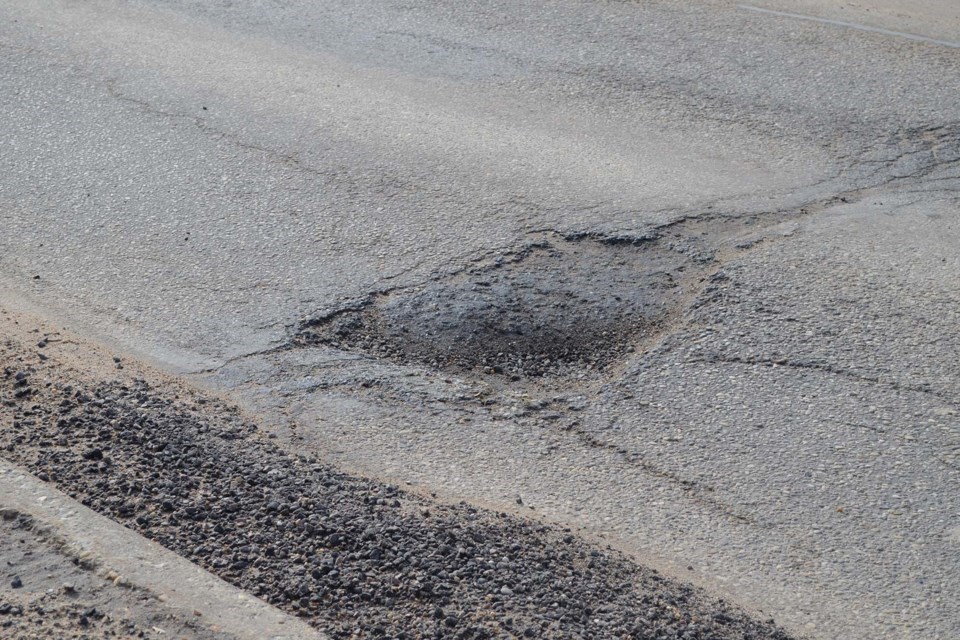More erratic and extreme weather will cause an increase in potholes and the need for repair work on roads in Alberta, says one expert.
Right now, St. Albert city staff have fewer potholes to repair than usual, according to the 2023 city budget, but a professor of earth and atmospheric sciences at the University of Alberta says this trend will likely reverse in the years to come.
City spokesperson Nicole Lynch told The Gazette that there are too many factors at play to determine a main cause of potholes in each particular year, but the proposed budget says there were fewer potholes to repair in 2021 because of reduced snowfall. The city repaired 1,343 potholes in 2021.
Potholes are formed in winter when water sinks into pavement and collects underneath, according to a 2015 Global News article.When the water freezes it expands, weakening the pavement by causing cracks and potentially displacing the asphalt. When the water eventually melts, a space between the ground and the asphalt is created and the pavement collapses, causing a pothole.
“We are due for more erratic and extreme weather, including the possibility of more humidity and precipitation,” said Jeff Birchall, who, on top of his regular duties as a professor at the U of A also serves as director of its Climate Adaptation and Resilience Lab.
“Snow accumulation could increase, and it could get wetter and heavier, and necessitate new or adapted snow-removal procedures,” Birchall said. "An expanded freeze and thaw period is also likely — and may even become more erratic, [possibly] occurring during the heart of cold months."
"Ultimately, I don't see things getting easier for road maintenance in Alberta," said Birchall.
By the numbers
According to the 2023 budget, in 2020 city staff repaired 1,745 total potholes, an increase over the previous two years.
"As there are a variety of reasons why potholes are formed, it’s not known if 2018 and 2019 had fewer repairs specifically due to reduced moisture [and] precipitation,” Lynch said.
"Looking back at the weather in 2018, there was a late spring snow and very cold temperatures, however, once the snow started melting, the moisture disappeared quickly which resulted in fewer freeze/thaws than in other years."
In April of this year, The Gazette reported that the city was expecting to repair twice as many potholes in 2022 compared to 2021, and had already repaired 370 potholes by the end of March.
In an email on Nov. 7, Lynch said the city's year-to-date pothole repair number was 1,503.
While Lynch said the city's budget for roadway services including the cost of repairing potholes was $611,300 in 2022, she couldn't say how much was spent on pothole repair alone. Lynch was unable to provide the proposed 2023 roadway services budget by The Gazette's print deadline.
Lynch said the city has three main methods of repairing potholes: cold-mix asphalt, hot-mix asphalt, and an infrared unit purchased in 2015.
"Cold asphalt is a temporary measure and not as strong as hot mix; however, it can be used in cooler weather as it does not require heating and can be installed quickly," Lynch said. She added, "it also reacts better when water is in the area until the pothole can be permanently addressed."
"Hot-mix asphalt provides a longer-term solution, but it needs to be kept warm and requires more time. It is more durable and flexible, and the city uses it as conditions allow to address larger potholes."
The infrared unit provides a permanent fix, Lynch said.
"Where there are significantly large holes, the existing asphalt is heated up with the infrared unit, material is added in along with a rejuvenator, and then it is all sealed permanently to turn it into one solid piece again."
Besides fixing potholes after they form, Lynch said the city actively employs a couple of different methods to prevent potholes.
"The city does preventative maintenance such as seal coating or micro-surfacing," Lynch said. "These practices extend the life cycle of the asphalt structure and prevent water from seeping in."
"If a road has experienced considerable breakdown this would be addressed through our engineering department, who will look at which roads need a full asphalt replacement."




